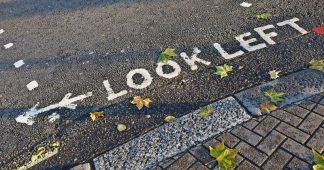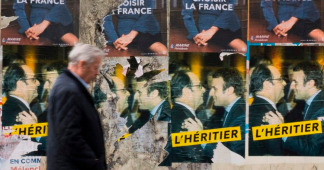I have noticed lately a curious term that appears repeatedly now in political discussions and in the media. It is a sort of leftist battle cry. The pervasive term is “intersectionality.” This term is typically advanced as a positive value. So far as I can make out, it is supposed to describe the way various political constituencies intersect at points of common interest. There seems to be some promise of inclusion, unity, and strength implied when one invokes the presence of intersectionality. Is this so, I have come to wonder. Equally, intersectionality now ranks among the cardinal virtues of “identity politics”—a topic everyone seems to be taking up these days. Is it so virtuous as all that? Are the identitarians, for that matter?
Intersectionality, according to Merriam Webster, means the complex, cumulative manner in which the effects of different forms of discrimination combine, overlap, or intersect. This seems mildly promising, so far as it goes. But look closely at the phenomena we all know as intersectionality and you find not the promise of greater inclusion and the prospect of greater power but something closer to tragedy. The intersectionality that American leftists increasingly advocate has a narrowing, not broadening effect. Here’s the salient bottom line: Follow this out, and it may lead to the collapse of the left, not its elevation.
I take a scientific and theoretical approach to intersectionality. To explain its dangers, I’m going to delve into set theory, a branch of mathematical logic dedicated to the study of the collection of objects. Bear with me. This logic is illuminating.
In set theory, a union of a collection of sets is defined as the set of all members of the collection. An intersection of a collection of sets is the set containing the membersthat belong simultaneously to all the respective sets. By definition, the union of sets contains the intersection of said sets. This is a trivially true mathematical statement. As the old labor unionists intuitively knew, there is power in a union.
The truth of that simple statement is well known to those lucky enough to belong to that ever-shrinking champion of workers, the labor union. However, the intersectional advocates on the left end of the political spectrum these days think differently—or believe differently, better put. In their view, the road to political victory will be achieved by assembling a narrow coalition of intersecting social and economic identity groups. This is intersectionality as it is supposed to work on the ground. But it rests on faulty logic. Why is this so?
The essential flaw lies in conflating the intersectionof sets with the union of sets. Take a minute to think about the difference. The way “intersectionality” is used today reminds me of Inigo Montoya, the character in the movie The Princess Bride. “You keep using that word,” he says. “I do not think it means what you think it means.” Inigo is talking about a completely different word, of course. (His word is “inconceivable”) But his point applies here. Intersectionality, far from having an inclusionary effect, actually excludes many, many people due to characteristics in them judged unwelcome. Intersectionality as a political strategy thus thwarts the objective of forming a large enough coalition capable of winning and effectively wielding political power.
For example, a common refrain among the intersectionalist left is that Trump won the 2016 election due to the racism of white people, working-class whites in particular, and therefore the set we call working-class whites has nothing to bring to the intersection, so to speak. It can be ignored as a potential ally in the struggle against neoliberalism. However, the set of all working-class white people is not the same as what we find at the intersection of the set of working-class white people and the set of racists. By conflating the two sets, the intersectionalists are
1) excluding a large set of people that have been crushed by neoliberalism and
2) committing themselves to a much diminished coalition.
The question is: Why is this idea of intersectionality, which is logically flawed on its very face, so prevalent among various leftist factions and “progressives”? There are two likely possibilities, in my view:
1) The Left is being deliberately fractured by government and corporate policies or
2) The Left is exhibiting a sort of schizophrenic break with reality induced by both a perpetual inability to obtain economic and social relief from neoliberalism and the election of Donald Trump.
Both possibilities involve concepts first discovered by a long dead intellectual named Gregory Bateson. Bateson was a scientific polymath, actively conducting research from the 1930s throughout the 1970s, in a wide array of fields including anthropology,semiotics, cybernetics, linguistics, and biology.
The first Batesonian concept I will introduce is called schismogenesis. Schismogenesis means the beginning of the breakdown of a relationship or a system. Bateson first developed it while observing the social interactions of a New Guinean tribe called the Iatmul. Interestingly enough, Bateson later weaponized the idea of schismogenesis and deliberately sowed divisions while working for the OSS, the precursor to the CIA. Whether artificial or engineered, the Left can be aptly described as suffering from Bateson’s schismogenesis: It long ago entered a breakdown phase.
The second concept relevant to the analysis of the current state of the Left is “the double bind.” After Bateson’s work for the OSS during World War II, he began investigating the complexities of communication. In particular, he was intrigued by schizophrenia and coined the term “double bind” during his research. A double bind consists of a sequence of injunctions that have the following structure: a primary negative injunction containing a threat of punishment, a secondary injunction, also containing a threat communicated verbally or nonverbally, that conflicts with the first injunction, and a tertiary negative injunction prohibiting the victims from escaping the field.
Bateson put it this way:
Our approach is based on that part of communication theory which [Bertrand] Russell has called the theory of logical types. The central thesis of this theory is that there is a discontinuity between a class and its members. The class cannot be a member of itself nor can one of the members be the class, since the term used for the class is of a different level of abstraction-a different Logical Type-from terms used for members.
I first noticed the connection between the double bind and the intersectional left while reading an article by Frank Bruni in the New York Times. Bruni quotes Mark Lilla, author of The Once and Future Liberal: After Identity Politics, in reference to identity politics: “You must understand my experience and you can’t understand my experience. They argue both, so people shrug their shoulders and walk away, he said.” This is the basic structure of a double bind.
A more concrete example is the case of Bret Weinstein, the former professor at Evergreen State College in Olympia, Washington. Weinstein, a progressive, refused to adhere to student demands for white people to stay off of Evergreen’s campus during a “Day of Absence” in 2017 and as a result was accused of being a racist. His accusers shouted him down when he attempted to engage them. Weinstein and his wife, also an Evergreen professor, eventually resigned. The double bind demand imposed on Bret Weinstein was as follows:
1) as a white person, Weinstein, claimed the students, should have left campus as a sign of respect and solidarity with oppressed people,
2) however, by conceding to the student demands, Weinstein would be giving in to a racist action(excluding white people), but
3 ) by resisting demands by the students to leave the Evergreen campus, Weinstein was labeled as a racist for not respecting oppressed peoples.
Interestingly enough, the creator of the term “intersectionality”, Kimberle Crenshaw, cites a double bind example as her inspiration for the concept in an interview with the journal Perspectives, published 2004. The piece is aptly titled, “Intersectionality: The Double Bind of Race and Gender”:
Perspectives: Tell me about the origins of your concept of intersectionality.
Crenshaw: It grew out of trying to conceptualize the way the law responded to issues where both race and gender discrimination were involved. What happened was like an accident, a collision. Intersectionality simply came from the idea that if you’re standing in the path of multiple forms of exclusion, you are likely to get hit by both. These women are injured, but when the race ambulance and the gender ambulance arrive at the scene, they see these women of color lying in the intersection and they say, “Well, we can’t figure out if this was just race or just sex discrimination. And unless they can show us which one it was, we can’t help them.
Crenshaw seems to be arguing that people who are simultaneously members of multiple sets of oppressed people (i.e. the intersection of sets) deserve delivery from injustice for each of the sets to which they belong. This leads to a bizarre, hierarchical system, where the more sets of oppressed people you belong to, the more important your claims to delivery from injustice, are. If one follows the consequences of such a system to its logical conclusion, any attempt to build alliances will fall apart due to the imbalance in power among its various members. The fragility and divisive nature of such a remedial system, built upon the shaky logical foundation of “intersectionality”, leads us to Bateson’s previously mentioned concept: schismogenesis.
The idea that the schismogenesis evident on the American Left is by design has some supporters. The political scientist Adolph Reed, Jr., has argued that identity politics is a weapon to prevent solidarity among the working class. The literary theorist and critic of identity politics,Walter Benn Michaels, has argued along similar lines that identity politics is a camouflage to cover up the economic warfare waged by elites. These arguments suggest Bateson’s legacy has lived on through the deliberate weaponization of the double bind and schismogenesis.
The other possibility is that the schismogenesis and implementation of double binds erupting on the Left is an emergent property of an oppressive economic system that thwarts all attempts by non-elites to obtain relief through conventional political means. For example, the neutralization of the Bernie Sanders campaign by the Democratic Party led to the ascension of Trump to the U.S. presidency. Perhaps this induced the current outbreak of protest among the vocal left in media and at universities, the last bastions of Leftist power.
In either case, this presents a problem for those who wish to develop a Left coalition capable of overcoming the neoliberal order, as the Right seems to have the advantage in cobbling together its different factions to form a ruling coalition in a way the Left simply cannot. The Left should heed the words of the late Marxist historian Eric Hobsbawm with regard to identity politics, of which intersectionality is a particular variant. Hobsbawm wrote in 1996:
So what does identity politics have to do with the Left? Let me state firmly what should not need restating. The political project of the Left is universalist: it is for all human beings. However we interpret the words,it isn’t liberty for shareholders or blacks, but for everybody. It isn’t equality for all members of the Garrick Club or the handicapped, but for everybody. It is not fraternity only for old Etonians or gays, but for every-body. And identity politics is essentially not for everybody but for the members of a specific group only.
Every advocate of “intersectionality” and the politics associated with it would do well to consider the late and great British historian’s point very carefully. The life of the American left may well depend on it.
* Haydar Khan is a former mathematics researcher and instructor at a public university in the U.S. South.
Published at https://www.counterpunch.org/2018/09/14/set-theory-of-the-left/











